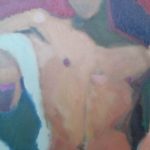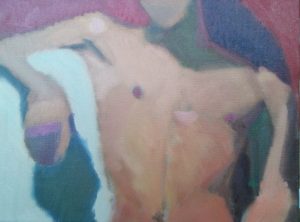Thinking about light on form

This week several teachers said we need to think about light on form when we are painting. Sounds easy enough – right? After all, seeing and showing light on form is the goal of almost any painting.
Here is a list of steps I have learned to best show light in a painting:
- introduce one piece of information at a time
- see the painting you want on the canvas before you start painting
- paint with calm energy
 These steps sound so easy, don’t they? To help facilitate the process, we painted a color study (limited to 3-hours) and a value study (limited to 3-hours) one day last week. These two studies help us get the color and value relationships right. My color study is here and I was quite pleased with it. Why? Because I kept the shapes simple, I focussed on the color relationships and I finished it in 3-hours.
These steps sound so easy, don’t they? To help facilitate the process, we painted a color study (limited to 3-hours) and a value study (limited to 3-hours) one day last week. These two studies help us get the color and value relationships right. My color study is here and I was quite pleased with it. Why? Because I kept the shapes simple, I focussed on the color relationships and I finished it in 3-hours.
The next day I started on the final painting and learned that my composition was too complex. In other words, I needed to simplify it so that I paint either the hand or the torso but not both. So, I decided to focus this painting on the torso. Why? Because I will have the opportunity to do several more of these paintings and will tackle more complex forms such as hands and feet then.
The teacher, Jafang Lu, did an amazing demonstration of painting the hand in light. Here’s a detail of that painting, too. I learned so many valuable steps in this process that I want to share them with you here:
- paint the gesture and block in shadow shapes
- choose a mid-light color value for the biggest shape
- get the drawing and value relationships right as you paint
- deal with light mass because most of the complexity lies there
- introduce one piece of information at a time
- once you have established the lights, get a clear idea of the color/value of the form shadow (on the form and any other objects in the painting) and paint one color note for this
- one way to choose the color in step 6 is to choose the color of the terminator in the shadow
- paint the cast shadow, then the lightest light and darkest dark
- constantly assess the colors and values you have used and paint the largest light value
- choose color/value for the dark light and paint it where you see it
- evaluate the existing shapes you have painted and ask yourself what you can do to the existing shapes to make the form stronger
- get the shapes of the planes right
- make sure each subsequent piece of information relates to the previous shapes and continue
Even though this describes a step by step process for completing a painting, I can relate to several steps that were useful to me in my previous work as a web designer. You may even be able to see some value in this if you are a writer or potter or sculptor. For instance, I always made sure to introduce one new piece of information at a time when I was building a new website. Why? So that if I got an error message, I could more readily see what the mistake was and correct it.
This is the latest update on light on form and art school here at Studio Incamminati in Philadelphia, PA. I hope the next time you see a painting that you love, you will consider the light and its impact on the subject.

6 Comments
Milissa
October 28, 2016Hi Julie! Wow! So many steps! What a challenge! A part of me thinks channeling while painting may be easier after reading all that this entails! Ha! I would imagine that once one is comfortable with the process, it just flows. I don’t know… I guess I am looking for the window (or open expanse) of creativity in the midst of lessons of which you speak. Do you ever feel confined by them? Not in a bad way, but I feel that the human eye/brain can tell the hand exactly what to do, the colors, shapes etc. if we let it flow. Practice of course helps, but sometimes thinking gets in the way. Trusting that connection is all important. It’s similar to that of a musician- their eyes look at the notes only, and the hands know exactly where to go, with practice once again I know. Does this make sense? Maybe I’m the one thinking too much, yes?!?! Anyway it’s all good. What a cool adventure you are on!
Before I forget, are you in philly over thanksgiving? We will be there. Have possibly a short window of time as we are just there briefly. Would love to see you!! Let me know when able. Can work something out. Sorry for using this venue for that message!! Love you! Take care…
Julie Holmes
October 29, 2016Hi Milissa,
This is pretty technical and rigorous (for me anyway) information I am learning. And, you mention musicians in your reply. In some ways. I am still at the stage where I am learning to practice musical scales with paint by doing these exercises and studies.
Prior to coming to school, I found I was sooooo frustrated by my inability to paint (or draw) what I imagined in my head.
This year I finally feel as if I am acquiring the skills to be able to do so but is not easy! Each study and challenge seems to be pointing me in the right direction. This feels so alluring and overrides any memories of frustration I had before coming to art school.
We would love to see you guys for Turkey day but will probably be making a quick dash back south ;-(.
So we will plan for another time and actually have some things percolating with David that may require occasional treks your way soon after I finish here – woot!
Stay tuned and lots o’love back at ya!!!
milissa
October 31, 2016Okay – now I get it! You are in the “practicing scales” part. 🙂 Makes more sense in the pea-brain of mine to put it that way. Pretty intense really. Cool stuff to be sure.
Cheers!
Beth D Clary
November 4, 2016I find this fascinating, Julie. While I can sort of see applications to writing I always find myself resisting step-by-step suggestions. Maybe I’ll do a few days of exercising my writing with these general principles and see what comes. I’ll report back. Thanks for sharing all this! XO
Barb keyworth
November 18, 2016I see this ( like practicing scales) as similar to practicing forms in martial arts or athletics. You have to train your brain and body. Cooking too- if i just go in and try to make something without knowing basic steps, i may have to order takeout. I dont see it as constraints to creativity but rather the foundation so you can organize the creativity.
Julie Holmes
November 18, 2016Hi Barb, So true! It’s all about practice and developing the skills to be able to practice with ease. Or, as one of my teachers says, “Paint with the end in mind and calm energy.”
Thank you for reading!